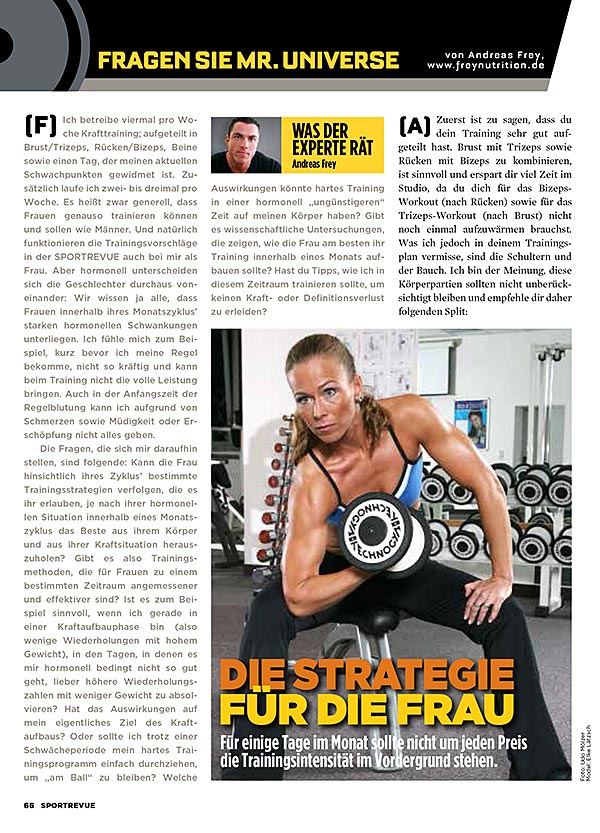COLUMN 75 |
THE STRATEGY
FOR THE WOMAN

FOR A FEW DAYS A MONTH, TRAINING INTENSITY SHOULD NOT BE THE FOCUS AT ALL COSTS.
The questions that arise for me are: Can a woman follow certain training strategies in relation to her cycle that allow her to get the most out of her body and her strength within a monthly cycle, depending on her hormonal situation? Are there training methods that are more appropriate and effective for women at a certain time? For example, if I am in a strength-building phase (i.e. few repetitions with high weight), does it make sense to do higher repetitions with less weight on days when I am not feeling so well due to hormonal reasons? Does this affect my actual goal of building strength? Or should I just stick to my hard training program despite a weak period in order to "keep up"? What effects could hard training have on my body during a hormonally "unfavorable" time? Are there scientific studies that show how women should best structure their training within a month? Do you have any tips on how I should train during this period so as not to suffer a loss of strength or definition?
ANSWER

- Day 1 (Monday): Chest/Shoulder/Triceps
- Day 2 (Wednesday): Legs/calves/stomach
- Day 3 (Friday): Back/Biceps
You can run on days when you don't train or immediately after weight training. After weight training, however, you shouldn't do endurance training for longer than 30 minutes. I believe that strength and endurance training can otherwise be too strenuous for the body, which is why there is a risk of muscle loss. The cardio sessions on days when you don't train can, however, take up to 60 minutes.
In general, there is actually no difference between the training principles of women and men. However, it is also true that a distinction must be made between men and women with regard to their hormonal conditions. If you suffer from major problems during your monthly period, I recommend that you speak to your gynecologist. He may be able to suggest ways to alleviate the hormonal-related symptoms. For example, using certain birth control pills can significantly shorten menstruation and limit its negative effects.As far as I know, there is no special training for the period. I am also not aware of any training studies on this aspect. I therefore recommend that you simply train according to how you feel. If you feel relatively weak due to menstruation but still don't want to miss out on your training, I advise you to only lift the weights that your current condition allows - this also applies to a strength-building phase. Afterwards, you should be able to continue training at the usual intensity without any loss of strength and muscle tone, I am convinced of that.
In view of the lack of studies, I recommend the following strategy: For three weeks a month, you train very hard and with full commitment. Make your training intensive, safe and no longer than 60 minutes. By "intensive" I mean to the point of absolute muscle failure and by "safe" I mean without momentum or cheating.
In one week of the month - during your period or immediately before - you train according to how you feel and avoid high intensity workouts if possible. This way you can use this one week per month to recover, which is very useful.This approach is also very popular with male bodybuilders and strength athletes, as it gives the body enough time to recover and thus grow. As we all know, the athlete's greatest enemy is overtraining - and you can get into that faster than you think! That's why you should look at the whole thing positively and follow my suggestions to make the best of the situation!
SEND US YOUR QUESTION!
Do you have any questions about bodybuilding, nutrition, training or supplements? Then send us your question by email to: INFO@FREYNUTRITION.DEThis will then be answered personally by Andreas Frey in the form of a column and published here!












